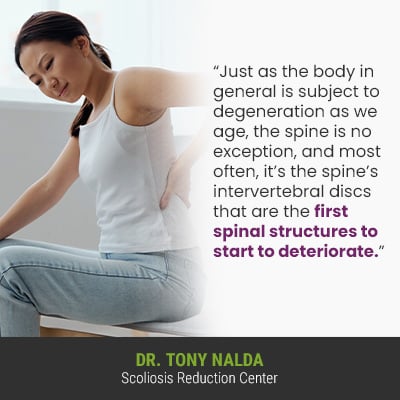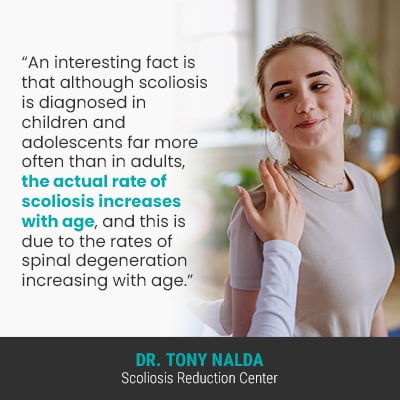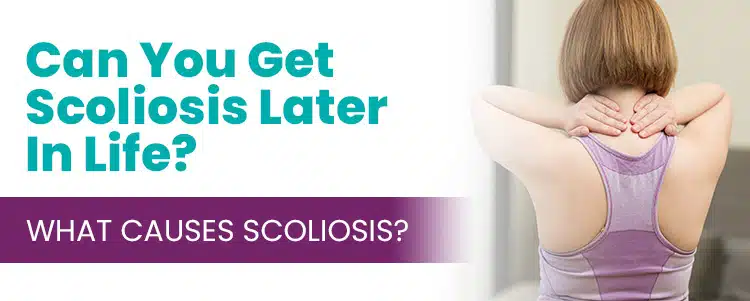The most common types of scoliosis to affect adults are idiopathic and degenerative. Idiopathic scoliosis doesn’t develop fresh in adulthood, but instead develops in adolescence as adolescent idiopathic scoliosis; these cases went undiagnosed and untreated during adolescence, and degenerative scoliosis involves natural age-related spinal degeneration common to adults over the age of 50.
Scoliosis can affect all ages, and while the condition is the most prevalent in children, it can also affect adults later in life as degenerative scoliosis. In addition, while scoliosis is more commonly diagnosed in adolescents, the actual rates of scoliosis increase with age. Understanding the potential scoliosis complications is crucial for managing the condition effectively as one ages.
Scoliosis ranges widely in severity and type; let’s explore the topic of getting scoliosis later in life by first defining the condition, and then moving on to the two main condition types to affect adults.
What is Scoliosis?
Scoliosis is the development of an unnatural sideways spinal curve that also rotates, making it a complex 3-dimensional condition.
In addition, in order to be considered a true scoliosis, the scoliotic curve has to be of a minimum size: Cobb angle measurement of at least 10 degrees.
A patient’s Cobb angle shapes the design of effective treatment plans and classifies conditions in terms of severity, and condition severity plays an important role in determining how noticeable a condition is.
The more severe the condition, the more noticeable its symptoms and effects are likely to be, including nerve pain and other discomforts, and the higher the Cobb angle, the more out of alignment the scoliotic spine is:
- Mild scoliosis: Cobb angle measurement of between 10 and 25 degrees
- Moderate scoliosis: Cobb angle measurement of between 25 and 40 degrees
- Severe scoliosis: Cobb angle measurement of 40+ degrees
- Very-severe scoliosis: Cobb angle measurement of 80+ degrees
When the spine’s healthy curves are in place, the spine is going to function as it was designed, with its natural curves making it stronger, more flexible, and better able to absorb/distribute mechanical stress incurred during movement.
If the spine develops an unhealthy curve, this disrupts the biomechanics of the entire spine, impacting its overall health, strength, and function.
Different Types of Scoliosis
As mentioned, not only does scoliosis range widely in severity from mild to very severe, there are also multiple condition types.
The most prevalent type of scoliosis is adolescent idiopathic scoliosis (AIS), diagnosed between the ages of 10 and 18, and idiopathic means not clearly associated with a single-known cause.
Idiopathic scoliosis accounts for approximately 80 percent of known diagnosed cases, with the remaining 20 percent consisting of types associated with known causes: neuromuscular scoliosis, degenerative scoliosis, and congenital scoliosis. In severe cases, scoliosis surgery may be considered to correct the spinal curvature and improve patient outcomes.
So which condition types are likely to develop, or be diagnosed, later in life?
Scoliosis Later in Life
Scoliosis can affect all ages from babies being born with the condition to infants between the ages of 6 months and 3 years as infantile scoliosis, early-onset juvenile scoliosis affecting those between the ages of 3 and 10, AIS affecting adolescents, and adults of all ages.
The two main types of scoliosis to affect adults are idiopathic and degenerative; idiopathic scoliosis is the main form to affect adults, so let’s start there.
Idiopathic Scoliosis in Adults
As touched on earlier, cases of idiopathic scoliosis in adults are cases of adolescents who had adolescent idiopathic scoliosis but were unaware; this is a common scenario because adolescent idiopathic scoliosis, particularly when mild, isn’t known as overly painful, nor does it commonly cause noticeable functional deficits.
Early detection of scoliosis in patients who have not yet reached skeletal maturity can be a challenge; scoliosis doesn’t become a compressive condition until adulthood, which is when it tends to become painful.
Compression (uneven pressure) of the spine and its surrounding muscles and nerves is the main cause of condition-related pain, and while postural changes are the main symptoms of scoliosis in children, pain is the main symptom that brings adults in for a diagnosis and treatment.
The constant lengthening motion of a growing spine counteracts the compressive force of the unnatural spinal curve, making it less noticeable and harder to diagnose.
When adulthood is reached and the condition becomes compressive, its effects are more noticeable, and this is what brings most adults in to see me, and by the time I see them, in many cases, significant progression has occurred; had these adults received a diagnosis and treatment during adolescence, their spines would be in far better shape.
So idiopathic scoliosis doesn’t develop fresh in adulthood, but that’s when the condition is commonly first diagnosed.
In these types of cases of being diagnosed with idiopathic scoliosis later in life, the goal of treatment is often to reduce the unnatural spinal curve back to the size it was prior to becoming painful, and to further stabilize the spine. Physical therapy plays a crucial role in managing idiopathic scoliosis in adults by improving flexibility, strength, and alignment.
The next most common type of scoliosis to affect adults is degenerative scoliosis.
Degenerative Scoliosis
Degenerative scoliosis is the second most common type to affect adults as they age and is caused by natural age-related spinal degeneration.
Degenerative scoliosis is common in adults over the age of 50, and is also more common in women than men: due to changes in hormone levels and bone density that accompanies menopause.

Just as the body in general is subject to degeneration as we age, the spine is no exception, and most often, it’s the spine’s intervertebral discs that are the first spinal structures to start to deteriorate.
The spinal discs sit between adjacent vertebrae (bones of the spine) and provide cushioning, structure, flexibility, and act as the spine’s shock absorbers.
When we’re born, the spinal discs are made up of approximately 80-percent water, but as we age, those fluid levels decrease, and if a disc experiences excessive fluid loss, it becomes desiccated and changes shape, losing height, and this affects the position of nearby vertebrae: compromising their ability to remain aligned with the rest of the spine.
In addition, certain lifestyle factors such as carrying excess weight, chronic poor posture, excessive alcohol consumption, smoking, leading a sedentary lifestyle, and repeatedly lifting heavy objects incorrectly can also increase the rate of age-related spinal degeneration in older adults.

An interesting fact is that although scoliosis is diagnosed in children and adolescents far more often than in adults, the actual rate of scoliosis increases with age, and this is due to the rates of spinal degeneration increasing with age.
It’s estimated that the actual rate of scoliosis in adolescents is between 2 and 4 percent, while the rate of scoliosis in adults is between 12 and 20 percent, with that rate increasing exponentially in adults over the age of 60: 68 percent.
Can You Develop Scoliosis in Adulthood?
Yes, it is possible to develop scoliosis in adulthood. Adult scoliosis can occur due to various factors, including degenerative changes in the spine, osteoporosis, or as a progression of a pre-existing curve. Degenerative scoliosis is a type of scoliosis that occurs in adults due to the breakdown of spinal disks and connective tissues. This type of scoliosis is often seen in adults over the age of 50 and can be exacerbated by lifestyle factors such as smoking and physically demanding jobs. These jobs often involve heavy lifting, bending, or twisting, which can accelerate the degenerative process. Adult scoliosis can cause symptoms such as back pain, numbness, tingling, and even breathing difficulties, significantly impacting the quality of life.
Conclusion
So what causes scoliosis later in life? While we don’t fully understand what triggers the initial onset of idiopathic scoliosis, we do know how to treat it, and we do know what causes the condition to progress: growth and development.
When it comes to idiopathic scoliosis in adults, we’re talking about cases of adolescent idiopathic scoliosis that were undetected and untreated, being left to progress with time and maturity into adulthood.
As scoliosis becomes compressive in adulthood, this is when it’s the most vulnerable to the condition’s uneven forces, in terms of spinal compression: the main cause of condition-related pain.
Natural age-related spinal degeneration also causes scoliosis later in life as the spine, and its individual structures, start to deteriorate, compromising the spine’s ability to maintain its natural curves and alignment.
As a progressive condition, scoliosis has it in its nature to worsen over time, and it’s often not until a condition becomes more severe that its effects are noticeable enough to lead to a diagnosis and treatment.
While treating scoliosis in children means a large focus is on counteracting progression, as young patients are facing the constand trigger of growth, when treating scoliosis in adults, the focus is more on reducing curves back to where they were prior to becoming painful, further stabilizing the spine, and pain management. In severe cases of degenerative scoliosis, spinal fusion may be recommended to stabilize the spine and correct the curvature.
So in the most common type of scoliosis to affect adults (idiopathic), it’s not that they develop fresh in adulthood, but this is when they are first diagnosed, and degenerative scoliosis is also known as de novo scoliosis, meaning it has developed in adulthood with no prior history.
Here at the Scoliosis Reduction Center®, I’ve treated all condition types, severity levels, and patients of all ages; the best time to start scoliosis treatment is always now as waiting can mean further progression and a condition that’s more complex to treat.




